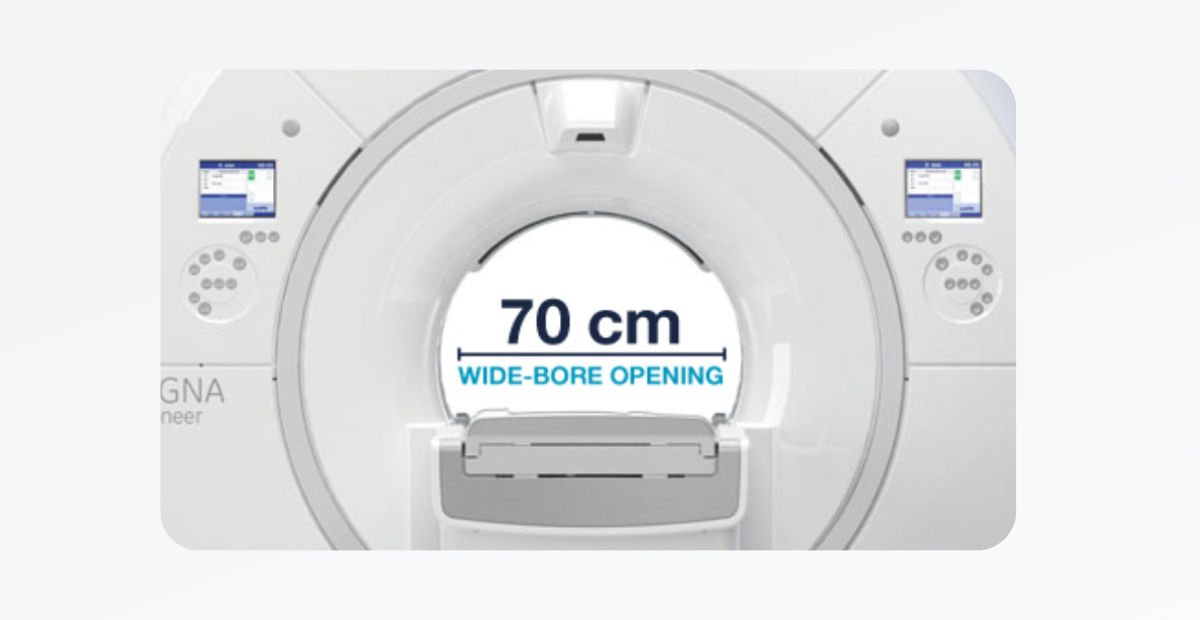Claustrophobia and MRI: 13 Tips From An MRI Tech

As and MRI Technologist, I have helped my fair share of claustrophobic patients get through their MRI.
Claustrophobia is no joke and struggling with anxiety related to small or enclosed spaces can make it seem difficult to get through your MRI scan.
This, added with the anxiety of knowing that your MRI scan may be medically necessary, can cause further anxiety and even lead to panic attacks.
Know that you are not alone. I have seen a large number of patients who know they have claustrophobia, and some who find out on the day of their scan.
But fear not!
If you suspect you might have claustrophobia and have an upcoming MRI scan, there is a lot you can do to prepare.
In this post, I will go over my top tips and tricks for reducing claustrophobia and anxiety during your MRI. This stems from my hands-on experience and what I have seen provide my patients the most success.
What Are My Top Tips For GettingThrough Your MRI if You Have Claustrophobia?
The top tips mostly include mind over matter and therefore are aimed at helping you get your mind off the exam so that you can sail through and be done before you know it!
There is not a whole lot the technologist can change in terms of the nature of the MRI scan you will take.
Since the primary goal is to get high- quality images, the way the scan is carried out will be oriented towards that goal.
However, I have also included some small adjustments that you can ask your tech to make on appointment day.
1. Stop Listening to Your Friends or Family Who Have Had Bad MRI Experiences

If I had a nickel for every time I had a patient come in extremely anxious because their aunt (or cousin or best friend) told them that their MRI was horrible, well, then I’d be rich.
I have worked at a number of clinics and hospitals over the course of my career and have had patients call in ahead of their scan freaking out because they got poor “advice” from a friend or family member.
About 95% of those patients (not an exaggeration), when they finally come in and see the scanning set up they are totally relieved to find it is not at all how they imagined and get through their scan with no issues!
They are usually shocked that they spent so much time agonizing over what they were told the scan would be like.
These friends or family are likely not experts, so leave it to the professionals.
Do yourself a favour, and say NO THANK YOU to people offering you nightmare fuel.
2. Tame Your Imagination
If you are lucky enough to not have people offering you their tales of MRI woe, then perhaps you still feel inclined to worry yourself to sleep imagining just how horrid your MRI will be.
In my experience, I have heard so many patients say that they imagined the worst but were pleasantly surprised at how easy their MRI actually was.
The lead up to the scan is often the worst part.
I have had so many patients explain just how worried they were for weeks leading up to their scan, only to find that it was pleasantly different than what they had expected.
The reality is that you won’t know until you get there and experience it yourself.
Some things that can be expected, regardless of where you get your scan are:
- The scanner tube (bore) will not close at any time and will stay open
- The scanner and MRI room will stay fully lit
- The scanner will not spin around you but stay stationary
- Whatever body part you will be getting scanned will need to be at the centre of the tube.
- MRIs will always be noisy and cannot be “turned down” in volume
- The MRI Tech will stay outside the entire time and will not leave
- You will be given a “call bell” which is a ball you can squeeze. This sets off an alarm so that the Tech knows you need urgent attention.
- Your head may still have to go in, depending on the body part being scanned
3. “Closed” Scanners are Actually Open at the Back

Picture a toilet paper roll.
This is exactly what a closed bore magnet is like.
Some patient I have had are surprised to find that the back of the magnet isn’t completely closed and that it actually opens up to the back of the room. Once they understand this, they have no issue hopping onto the scanning table.
4. Find a Facility With a Wide Bore MRI

Here is a view from inside an MRI machine.
Conventional closed MRIs are 60cm in diameter. This is what people typically think of when they imagine an MRI machine.
Wide bore MRIs are 70cm in diameter. They are also shorter. The overall effect is a much more open feel.
If going in head first, your head will be closer to the wider opening at the back.
The good news is that the smaller bore machines are slowly being phased out. Most facilities are now opting for wide bore magnets.
Since these are becoming more popular, most major North American cities have this option.
Bring this up with your doctor and he or she may be able to specifically request this for you.
Some sites do have a completely open bore MRI.
Although these are less common and it may be difficult to find a location near you. Also, keep in mind that these types of scanners may offer lower quality images, as the magnetic field may be lower in quality due to the open nature of the scanner.
5. Don’t Worry About What Your MRI Tech Thinks
If you are struggling with anxiety, or find out you have claustrophobia during your appointment, do not hesitate to bring this up with the technologist.
The fact is, as MRI techs, we see this all of the time. It is nothing new to us and it is simply a part of our daily jobs.
We do not think you are weird and we are trained to help see you through your scan and make sure you are as comfortable as possible.
6. Bring Some Support
Most scanning facilities will allow you to bring family or friends for moral support. Some facilities may even allow your loved one to accompany you into the scan room. Although, this is entirely up to the facility and technologist performing the scan. Make sure that this person is not someone who is scared of MRIs, claustrophobic, or anxious themselves.
7. Ask To Listen to Music or Watch a Movie
Some sites have the ability to provide MR- Safe headphones and have music for you to listen to. This is an awesome way to zone out and listen to your favourite tunes.
Some sites have set ups that allow you to watch a show. Although this is not common as the TV equipment that can go in the magnet room is extremely expensive!
8. Try Closing Your Eyes or Request an Eye Mask
Out of sight, out of mind.
If you are in the scanner and you choose to open your eyes, chances are you will be staring straight at the top of the tube. If that is all you see, then that is all you will think about. For most, this is unsettling. It was, even for me. I personally found it much easier to just close my eyes and simply think of something else.
Your grocery shopping list
Your to-do list for tomorrow
Take a mental stroll through your old high school
Really, just anything to get your mind off of where you are, as thinking about the scan while you are in the machine can lead you down a path that ends in panic.
9. You Can Request a Mirror

Depending on the type of scan there may be an option to request a mirror. This will allow you to see up and out of the scanner tube, which may help you pretend you are not inside.
10. You Can Request to Go Feet- First

Certain body parts can be scanned going feet- first into the machine. If you have apprehension about entering the scanning tube head first then this may be a good option for you.
However, not all exams can be done feet first and it is ultimately up to your technologist to decide what is appropriate for the exam.
Here is a list of exams that can be done feet first:
- Foot
- Ankle
- Calf
- Knee
- Hip
- Lumbar Spine
- Pelvis
- Abdomen
Here is a list of exams that cannot be done feet first:
- Head
- Cervical Spine
- Neck
- Chest
- Thoracic Spine
- Shoulder
- Breast
- Heart (Cardiac)
10. Know That Your Scan May Require You To Have Equipment Placed On Top Of You
These pieces are what we call “coils”. They are responsible for transmitting radio-frequency and are necessary to capture the image. The coils may cause a heightened sense of claustrophobia as some may not be comfortable with the idea of being covered.
Essentially, the body part being examined needs to have a coil placed underneath or above, sometimes both.
So if you are going in for a head or brain MRI, then you will have to wear the helmet coil.
If you are going in for a knee MRI, then you will go in feet-first with your knee region covered with a coil.
If you are going in for a whole body MRI then you will be covered from head to toe in coils.
10. Ask Your Doctor for a Sedative
Your doctor or primary healthcare provider may be able to prescribe you medication to help take the edge off of your anxiety.
For instance, Lorazepam (Ativan) or Alprazolam (Xanax) may be prescribed by a doctor.
Your doctor may also be able to prescribe you something a bit stronger.
You will have to pick this prescription up from a pharmacy before your appointment.
If you do opt for medication, you will not be able to drive and will have to arrange for a safe ride home.
Also, please keep in mind that for some exams, you may need to stay alert and awake.
Such as abdominal studies that may require you to hold your breath for optimal imaging.
11. You May Have to Come Back and Try Again
If you tried to get through your MRI and was unsuccessful, thats okay. It happens. If for some reason you were unprepared or felt out of sorts, there is usually an option to return and try again.
12. Split Up Multiple Exams
If you have multiple body parts that need to be scanned, it may be best to split them up to shorten your appointment. Although, some exams may have to be done together, especially if there is a dye injection needed.
13. You May Require Full Sedation
This is usually a last resort and is only done for exams that are deemed absolutely medically essential. In most cases if you find you are too anxious to undergo your MRI scan, despite trying the above tips, then your doctor will look for an alternative test to diagnose your suspected condition.
This is rare as it usually requires the presence of an anesthesiologist or anesthesia assistant. Depending on the type of sedation used, there may also be a need to maintain an open airway via a breathing tube.
As you can imagine, this is a much more invasive and involved procedure and is only reserved for extremely high priority cases in which the MRI images are necessary for diagnosis.
What is Claustrophobia?
According to the diagnostic and statistical manual for mental disorders (DSM 5), claustrophobia is listed as a specific phobia of small or enclosed spaces.
It comes from the word claustrum, which is Greek for “a closed place”.
Sounds about right.
This fear can lead to involuntary panic attacks, which may include:
- rapid heart rate
- sweating
- shaking
- chills
- chest pain
- difficulty breathing
- tingling or numbness
- dizziness
Is MRI Scary?
After all of this you are probably wondering
How Can These Tips Benefit You?
If you have an upcoming MRI appointment, it was likely ordered by a doctor and is deemed medically necessary. It can be really hard for those that are claustrophobic to go into the exam not knowing the options that are available to them to make their experience easier.
Some of these tips require preparation before hand, such as talking to your doctor about sedation options or bringing a support person with you.
How I Came Up With These Top Tips
I have been a full-time MRI Technologist since 2016. I have worked at many different hospitals and private clinics.
I have been involved in almost every type of MRI procedure from paediatrics, to breast biopsies, to full on anesthesia cases to ICU.
Needless to say I have seen all manner of patients in a variety of different situations.
This list was put together including tried and true methods that are taught at technical schools for medical imaging. As well as from my own experience with patients and seeing first-hand what works the best for most people.
Wrapping Up
Many people experience claustrophobia and fear that it will result in them aborting their MRI appointment. However, a large majority of those people actually successfully make it through.
The best course of action is to educate yourself beforehand to make sure that you are prepared with Ativan, a good support system, and a plan to distract yourself while you are in the scanner. Remember, you are not alone in feeling anxious and your technologist is there to help get you through successfully!
This is the best recipe for success!






